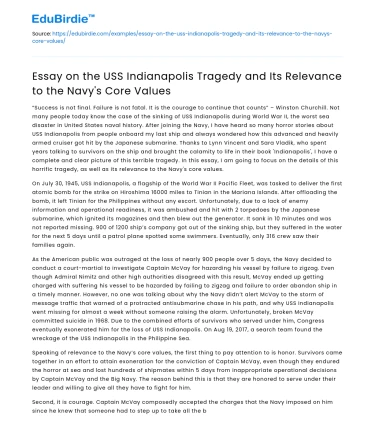“Success is not final. Failure is not fatal. It is the courage to continue that counts” – Winston Churchill. Not many people today know the case of the sinking of USS Indianapolis during World War II, the worst sea disaster in United States naval history. After joining the Navy, I have heard so many horror stories about USS Indianapolis from people onboard my last ship and always wondered how this advanced and heavily armed cruiser got hit by the Japanese submarine. Thanks to Lynn Vincent and Sara Vladik, who spent years talking to survivors on the ship and brought the calamity to life in their book 'Indianapolis', I have a complete and clear picture of this terrible tragedy. In this essay, I am going to focus on the details of this horrific tragedy, as well as its relevance to the Navy's core values.
On July 30, 1945, USS Indianapolis, a flagship of the World War II Pacific Fleet, was tasked to deliver the first atomic bomb for the strike on Hiroshima 16000 miles to Tinian in the Mariana Islands. After offloading the bomb, it left Tinian for the Philippines without any escort. Unfortunately, due to a lack of enemy information and operational readiness, it was ambushed and hit with 2 torpedoes by the Japanese submarine, which ignited its magazines and then blew out the generator. It sank in 10 minutes and was not reported missing. 900 of 1200 ship’s company got out of the sinking ship, but they suffered in the water for the next 5 days until a patrol plane spotted some swimmers. Eventually, only 316 crew saw their families again.
Save your time!
We can take care of your essay
- Proper editing and formatting
- Free revision, title page, and bibliography
- Flexible prices and money-back guarantee
As the American public was outraged at the loss of nearly 900 people over 5 days, the Navy decided to conduct a court-martial to investigate Captain McVay for hazarding his vessel by failure to zigzag. Even though Admiral Nimitz and other high authorities disagreed with this result, McVay ended up getting charged with suffering his vessel to be hazarded by failing to zigzag and failure to order abandon ship in a timely manner. However, no one was talking about why the Navy didn’t alert McVay to the storm of message traffic that warned of a protracted antisubmarine chase in his path, and why USS Indianapolis went missing for almost a week without someone raising the alarm. Unfortunately, broken McVay committed suicide in 1968. Due to the combined efforts of survivors who served under him, Congress eventually exonerated him for the loss of USS Indianapolis. On Aug 19, 2017, a search team found the wreckage of the USS Indianapolis in the Philippine Sea.
Speaking of relevance to the Navy’s core values, the first thing to pay attention to is honor. Survivors came together in an effort to attain exoneration for the conviction of Captain McVay, even though they endured the horror at sea and lost hundreds of shipmates within 5 days from inappropriate operational decisions by Captain McVay and the Big Navy. The reason behind this is that they are honored to serve under their leader and willing to give all they have to fight for him.
Second, it is courage. Captain McVay composedly accepted the charges that the Navy imposed on him since he knew that someone had to step up to take all the blames. It is his job, as a commanding officer, to take responsivity for the loss of the warship, despite the fact that Hashimoto, the commander of the Japanese submarine told the U.S. Navy that there is nothing Captain McVay can do to prevent USS Indianapolis from that tragedy.
And finally, it is commitment. There was a survivor reunion to be held on the 15th anniversary of the sinking. Captain McVay was shocked when he received the invitation letter to be a guest speaker. As soon as he stepped out of the plane, he saw twin lines of people, forming a path across the tarmac to the terminal. Someone shouted “Attention on deck!” when he got to the bottom of the stairs. It is committed that you, as a leader, try your best to take care of your Sailors and they will give everything they have to support and respect you at any time.
With diligent research and compelling writing, Lynn Vincent and Sara Vladic have accomplished outstanding history nonfiction. As their propulsive narrative goes from wartime to courtroom, their details encompassing this casualty and its shape-shifting aftermath will not only enhance your understanding of the honor, courage, and commitment of U.S. Navy sailors but also shine a light on their pursuit of truth and justice. It is really rare to see a historical artwork that can bring tears to your eyes. You will realize how stressful a good leader has to act in the big picture and how many responsibilities he has to take as a boss. In order to be a good leader, the first thing you have to know is how to serve your people.






 Stuck on your essay?
Stuck on your essay?

